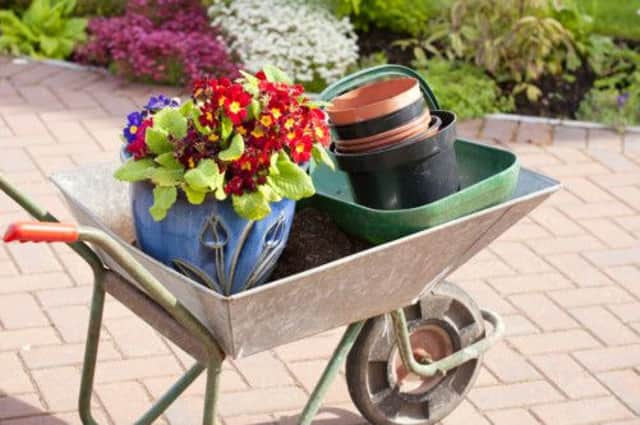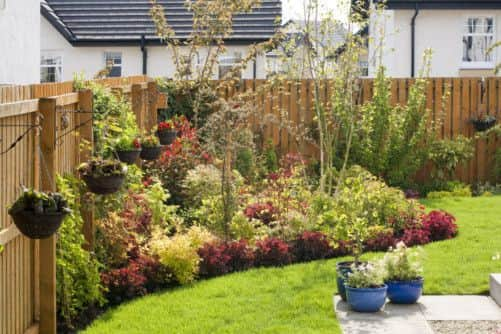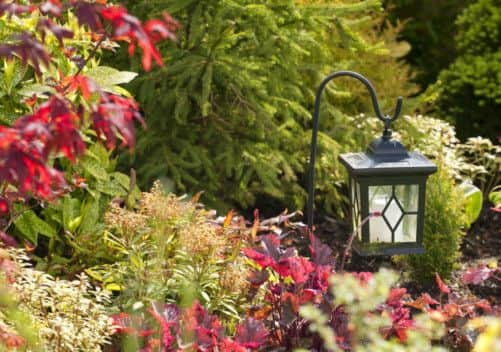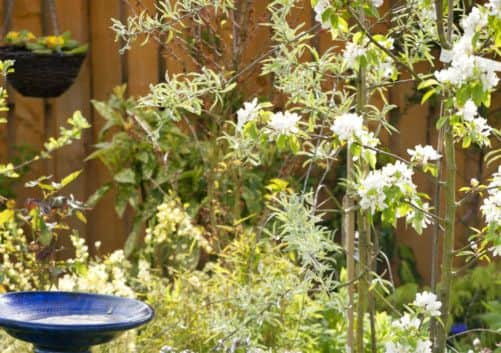Gardens: A blank canvas for a colourful garden


There was barely any time for the dust to settle when Helen and David Raeside moved into their home. The new-build house was a completely blank canvas for the couple, as was their garden, a patch of earth. But it didn’t stay that way for long. When the couple arrived, it was with more than 100 plants on the back of a float. Still in their pots, many were laid along the front. The garden seemed to have got up and running almost overnight, much to neighbours’ admiration.
In fact, much work had to be done to improve the soil, which was mostly builders’ rubble. Plenty of compost was added and the back was rotavated a few weeks after the Raesides moved in. But the appealing prospect of starting from scratch has resulted in a garden full of colour combinations of their favourite plants. No space is wasted in the series of beds that wrap around the edges of the lawn, or on the fences and drainpipes clad with pots and baskets.
Advertisement
Hide AdAdvertisement
Hide AdThe front started as a rectangle and now has four oval beds. A straight bed along the front has euonymus in alternating green, silver and gold, plus anemone blanda in purplish blue.


There are tête à tête daffodils and muscari (grape hyacinth) in the side bed. What to put at the front was dictated by the curve of the driveway, says Helen, with two of the oval beds following the shape.
This has influenced the adjacent bed, which is long enough to accommodate pyracantha, lupins, polyanthus and tête à têtes. Then it’s through a side gate to the back. The beds here are undulating, or have a touch of the wigglies, as Helen describes it. The couple have injected curves to add depth and distance to the front and back. Flowers for all the seasons are grouped around fruit trees and the lawn. There’s also a greenhouse, patio, pots and hangers.
Over four years the garden has matured to well-thought-out planting schemes and to look like it grows itself. But like most gardens that look like the work is done, it takes a lot of effort. “David digs holes, carries compost and cuts the grass,” says Helen, “and I do the rest.”
The couple, who are both 77 this year, retired to the Ayrshire village of Dunlop four years ago, from Newton Mearns, where Helen had worked as a music lecturer and David was a farmer.


They may have had plenty experience of the land to bring to their new surroundings, but still make mistakes. “David bought a strimmer thinking it was the easy way to do the edges and when I came back there were bits of grass so bald we had to re-seed.” It was a nail-biting few weeks to see whether it would take in time for the garden opening as part of the village’s open gardens two years ago.
The back garden is about 40ft long. The first section is themed red, using varieties of pieris, euphorbia and dogwood. Then they move on to the yellow area with daisies, daffodils, coreopsis, broom and roses.
The next curved bed is blue and makes use of striking architectural plants such as sea holly (eryngium) and the globe thistle (echinops). These summer spikes are softened by delphiniums and forget-me-nots. Primula ‘Francisca’ brings a touch of the unusual with its ruffles of lime green flowers. A pink and white bed has compact buddleja trees, clematis Montana climbing the fence, poppies, small bush roses, flowering currants and honeysuckles.
Advertisement
Hide AdAdvertisement
Hide AdThe colours have been complemented with ornaments and pots, and Helen uses plants such as violas to make sure winter’s meagre offerings in Scottish gardens have a splash of colour. A Juliet balcony on the house recalls a holiday the couple had in Verona. In summer, its window boxes hold scarlet geraniums and trailing lysimachia.


Helen brings imagination to all corners of the garden and shops around for ways to turn the mundane into something eye-catching. Pots that hang on drainpipes are the perfect home for annuals such as daisies and trailing geraniums. “David leaves it to me to choose,” she says.
So, back to the garden that looks like it takes hardly any work. To the owner of a bare patch of would-be garden, Helen has a few tips. “If you want to keep grass then you need to cut it regularly – even if you cut the edges it looks manicured. Put in some wigglies. Or if you don’t want to get too involved, get some pots. Look for plant deals in garden centres.”
She has problems too: ligularia is prone to vine weevil, and Helen’s was no exception. “Things don’t always work,” she says.
But when they do, it makes a garden that stands out from its surroundings. A bare patch of earth is a chance to put personality into a garden.
• A number of suburban and small gardens have open days this summer under Scotland’s Gardens. Visit www.scotlandsgardens.org for locations.
Plant Sense: ‘Most seeds won’t germinate below a soil temperature of about 7°C’
The planting season is about a month behind, so guidance on seed packets for late spring is just plain wrong. A neighbour at Pilrig allotments knows her planting time by the sparkly blue appearance of her comfrey’s flowers (Symphytum caucasicum).
Advertisement
Hide AdAdvertisement
Hide AdIn times gone by, apparently some gardeners used to roll down their breeches and sit with their exposed glutinous maximus to judge if the soil temperature was warm enough to plant. A less-exposed way would be to use your elbow, as if testing the temperature of bath water. If you prefer a more scientific approached there is a soil thermometer. The Royal Horticultural Society says most seeds won’t germinate below a soil temperature of about 7°C (45°F). On BBC’s Beechgrove Garden they covered a raised bed containing manure with black plastic and raised the soil temperature by 5°C without any heating aids. This gives an important head start to the short growing season of their sunny Aberdeen garden. This year, I am giving seeds a helping hand with the protection of two curved glass shower screens propped against bamboo canes.
Back to comfrey and its many uses, which include:
• Soil conditioner – dig the leaves into the soil – it improves growth under seed potatoes.
• Compost bin activator – lay layers of comfrey leaves to help speed up decomposition.
• Mulch – to suppress weeds and reduce water loss.
• Homemade liquid feed – chopped comfrey leaves in a container with a tight lid (with foliage weighed down with a stone) produces brown comfrey juice. Dilute juice with 10 parts water to one part juice to make a liquid feed. Top up leaves regularly to continue juice production.
Apparently comfrey foliage is richer in nitrogen and potash than farmyard manure, and the reason it rots down quickly because it has a great carbon/nitrogen ratio.
Rebecca Govier, Garden Designer (0781 750 5571, www.greenedgegardendesign.co.uk)